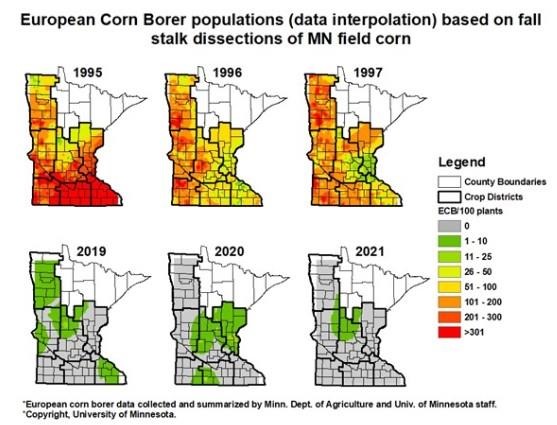By Anthony Hanson
Each year in September and October, U of M research and extension scientists conduct a state-wide survey to determine the percentage of plants infested with European corn borer (ECB) in growers' fields. This year, we plan to sample approximately 125 fields primarily across the western half of the state, though we may include some eastern locations depending on availability. A handful of fields are randomly selected in each county to represent the primarily predominant Bt acres where ECB populations are usually low due to the protection conferred by Bt traits specific to ECB. However, because ECB populations are inherently low in fields with protection, non-Bt fields are also needed in the survey to get a more accurate snapshot of populations and potential risk. Scouts visually inspect stalks for feeding damage and larval presence, so no effort or specialized plots on the grower's part is needed for a field to be included in the survey.
This Minnesota Corn Research and Promotion Council funded effort helps give growers an idea what the risk for European corn borer will be the following year and if reducing Bt acreage is feasible to lower production costs while avoiding yield loss from ECB. Historically, ECB, was the primary insect pest of corn in the state, but since the introduction of Bt traits, its population has dropped significantly (Fig. 1). However, ECB can still be present across the state in varying density, and there is potential for ECB to overcome Bt resistance, so this continued monitoring helps us determine if or when ECB may make a resurgence in the state.

Figure 1. Historical overwintering fall ECB populations (1995-1997) comparing a pre-Bt era infestation peak (1995), with the early years of commercialization (1996-1997), and with recent years (2019-2021). Source: UMN Extension IPM Program.
If you have a corn field that was planted entirely as non-Bt this year (or specifically without above-ground or lepidopteran traits) and would like to submit it as a potential survey site, please use this form or email the following to Anthony Hanson (hans4022@umn.edu).
- You name
- Phone number
- Field location (GPS or County, Township, Section & description of field)
- Coordinates can be easily found by finding your field in Google Maps, right clicking, and selecting What's Here?
Fields that are relatively accessible from a roadside are preferred. Submissions will be selected to give the best geographic representations of study sites. Growers will be advised if their field has a high population of borers, but individual field locations and farmer information will not otherwise be shared. Scouting will begin in early September, so early submission, especially before harvest season, is appreciated.
Source : umn.edu